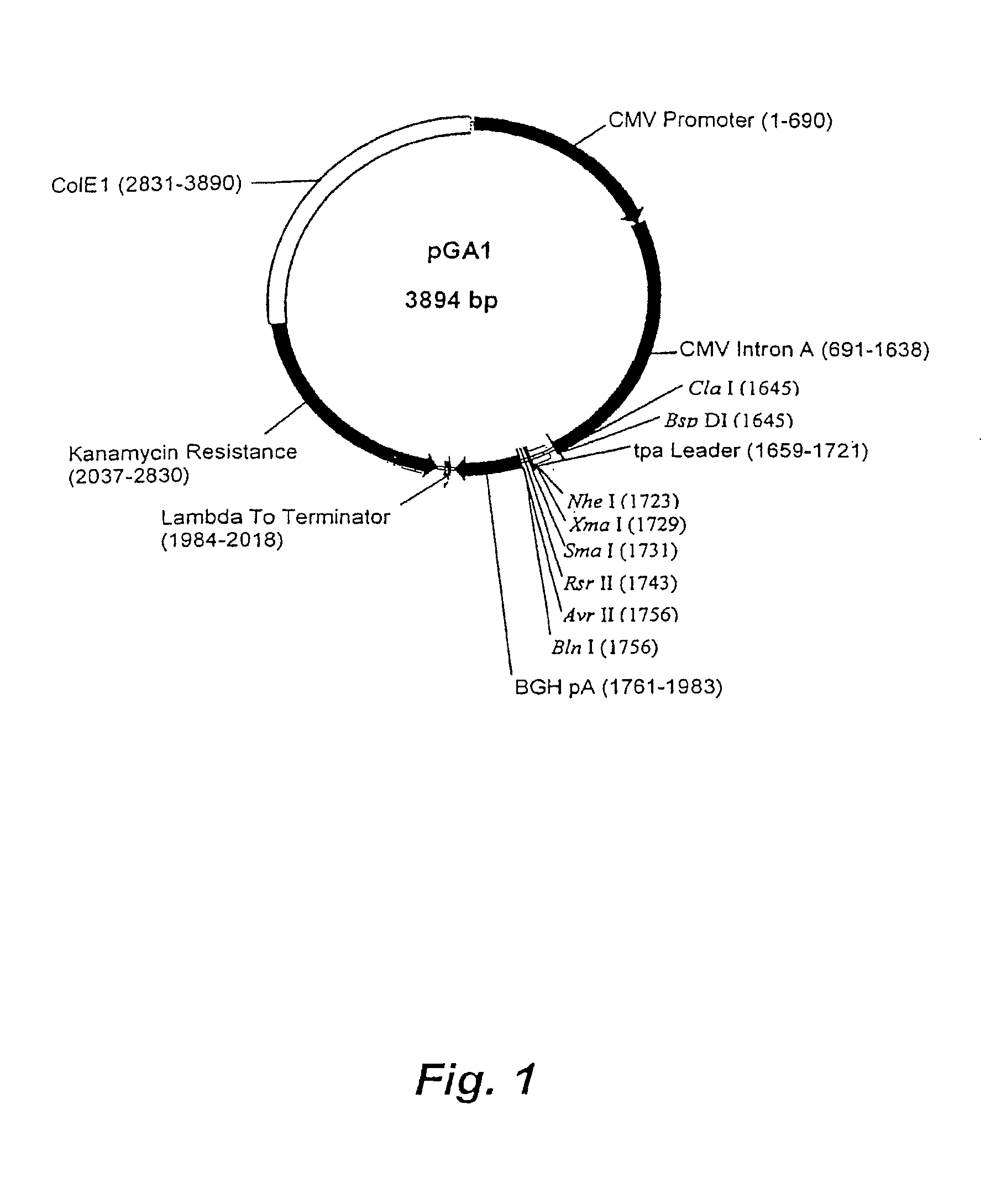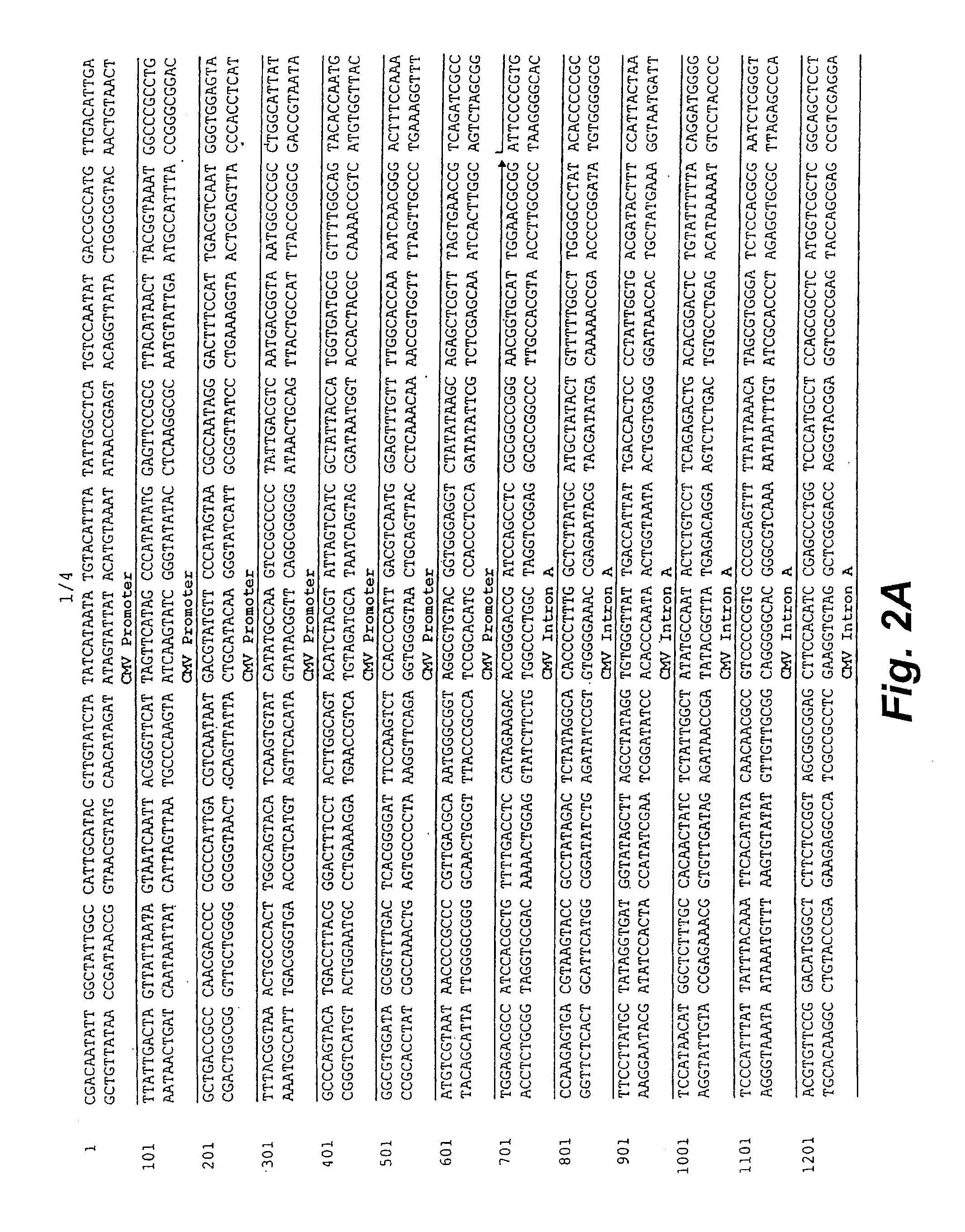DNA expression vectors and methods of use
a technology of dna expression and vectors, applied in the field of molecular genetics and immunology, can solve the problems of limiting the immunization of products encoded by dna (e.g., proteins), new threats and challenges to vaccine development, and the potential for atypical processing of bacterial and parasitic proteins by eukaryotic cells
- Summary
- Abstract
- Description
- Claims
- Application Information
AI Technical Summary
Problems solved by technology
Method used
Image
Examples
example 1
Structure and Sequence of PGA1
[0110]pGA1 as illustrated in FIG. 1 and FIG. 2 contains the ColE1 origin of replication, the kanamycin resistance gene for antibiotic selection, the lambda T0 terminator, and a eukaryotic expression cassette including an upstream intron. The ColE1 origin of replication is a 600 nucleotide DNA fragment that contains the origin of replication (ori), encodes an RNA primer, and encodes two negative regulators of replication initiation. All enzymatic functions for replication of the plasmid are provided by the bacterial host. The original constructed plasmid that contained the ColE1 replicator was pBR322 (Bolivar, et al. 1977; Sutcliffe, et al. 1978).
[0111]The kanamycin resistance gene is an antibiotic resistance gene for plasmid selection in bacteria. The lambda T0 terminator prevents read through from the kanamycin resistance gene into the vaccine transcription cassette during prokaryotic growth of the plasmid (Scholtissek and Grosse, 1987). By preventing ...
example 2
Structure and Sequence of PGA2
[0119]pGA2, as illustrated in FIG. 3, and FIG. 4, is identical to pGA1 except for delation of the intron A sequence from the CMVIE promoter. pGA2 was created from pGA1 by introducing a Cla I site 8 by downstream from the mRNA cap site in the CMVIE promoter. The Cla I site was introduced using oligonucleotide-directed mutagenesis using the complimentary primers
[0120]
(SEQ ID NO: 7)5′-CCGTCAGATCGCATCGATACGCCATCCACG-3′and(SEQ ID NO: 8)5′-CGTGGATGGCGTATCGATGCGATCTGACGG-3′.
[0121]After insertion of the new Cla I site, pGA1 was digested with Cla Ito remove the 946 by Cla I fragment from pGA1, and then religated to yield pGA2.
example 3
Structure and Sequence of PGA3
[0122]pGA3 as shown in FIG. 5 and FIG. 6 is identical to pGA1 except for the introduction of a HindIII site in stead of the ClaI site at nt 1645 and a BamHI site instead of the RsrII site at nucleotide 1743.
PUM
| Property | Measurement | Unit |
|---|---|---|
| distance | aaaaa | aaaaa |
| volume | aaaaa | aaaaa |
| pH | aaaaa | aaaaa |
Abstract
Description
Claims
Application Information
 Login to View More
Login to View More - R&D
- Intellectual Property
- Life Sciences
- Materials
- Tech Scout
- Unparalleled Data Quality
- Higher Quality Content
- 60% Fewer Hallucinations
Browse by: Latest US Patents, China's latest patents, Technical Efficacy Thesaurus, Application Domain, Technology Topic, Popular Technical Reports.
© 2025 PatSnap. All rights reserved.Legal|Privacy policy|Modern Slavery Act Transparency Statement|Sitemap|About US| Contact US: help@patsnap.com



